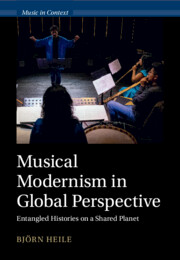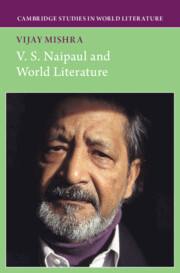126 results
Chapter 24 - Border Crises
- from Part IV - Anxious Neighbourhoods, Uncertain Futures
-
-
- Book:
- Europe in British Literature and Culture
- Print publication:
- 13 June 2024, pp 385-419
-
- Chapter
- Export citation
Introduction
-
- Book:
- Musical Modernism in Global Perspective
- Published online:
- 23 May 2024
- Print publication:
- 30 May 2024, pp 1-28
-
- Chapter
- Export citation

Musical Modernism in Global Perspective
- Entangled Histories on a Shared Planet
-
- Published online:
- 23 May 2024
- Print publication:
- 30 May 2024
Post-Soviet power hierarchies in the making: Postcolonialism in Tajikistan’s relations with Russia
-
- Journal:
- Review of International Studies , First View
- Published online by Cambridge University Press:
- 22 April 2024, pp. 1-21
-
- Article
-
- You have access
- Open access
- HTML
- Export citation

V. S. Naipaul and World Literature
-
- Published online:
- 01 February 2024
- Print publication:
- 08 February 2024
5 - Sector Theorists Should Consider How Social Values Determine Unmet Needs
- from Part II - Reflections and Refinements
-
-
- Book:
- Reimagining Nonprofits
- Published online:
- 11 January 2024
- Print publication:
- 01 February 2024, pp 91-112
-
- Chapter
- Export citation
Postsocialism in International Relations: Method and critique
-
- Journal:
- Review of International Studies / Volume 50 / Issue 3 / May 2024
- Published online by Cambridge University Press:
- 01 February 2024, pp. 494-513
- Print publication:
- May 2024
-
- Article
-
- You have access
- Open access
- HTML
- Export citation
“These Somalis are not Somalis:” Cup of Art Italian Coffeehouse, Authentic Identities, and Belonging in Hargeisa, Somaliland
-
- Journal:
- African Studies Review , First View
- Published online by Cambridge University Press:
- 22 December 2023, pp. 1-20
-
- Article
-
- You have access
- Open access
- HTML
- Export citation
Chapter 2 - Decolonizing the English Department in Ireland
- from Part I - Identities
-
-
- Book:
- Decolonizing the English Literary Curriculum
- Published online:
- 02 November 2023
- Print publication:
- 09 November 2023, pp 42-59
-
- Chapter
-
- You have access
- Open access
- HTML
- Export citation
Epilogue
-
- Book:
- The Jewish Imperial Imagination
- Published online:
- 08 November 2023
- Print publication:
- 09 November 2023, pp 179-192
-
- Chapter
- Export citation
‘It's not cricket’: Financial time and postcolonial temporalities in Joseph O'Neill's ‘Netherland’
-
- Journal:
- Finance and Society / Volume 4 / Issue 1 / 2018
- Published online by Cambridge University Press:
- 09 November 2023, pp. 92-107
-
- Article
-
- You have access
- Open access
- Export citation
Postcolonial Pessimisms and Alternative Spatial Practices: Critical Interpretation of the concept of the Third Space through the Case of Fatahillah Square, Indonesia
-
- Journal:
- TRaNS: Trans-Regional and -National Studies of Southeast Asia , First View
- Published online by Cambridge University Press:
- 09 October 2023, pp. 1-11
-
- Article
-
- You have access
- Open access
- HTML
- Export citation
6 - Postcolonialism and Bias in International Criminal Law
-
- Book:
- The Authority of International Criminal Law
- Published online:
- 27 July 2023
- Print publication:
- 07 September 2023, pp 94-111
-
- Chapter
- Export citation
38 - Riddling the Nation
-
-
- Book:
- The Cambridge History of the Australian Novel
- Published online:
- 28 June 2023
- Print publication:
- 27 July 2023, pp 646-661
-
- Chapter
- Export citation
Postcolonialism and Regimes of Time: Anniversary Journalism of the Hong Kong Handover in British and Chinese Newspapers, 1998–2020
-
- Journal:
- The China Quarterly / Volume 256 / December 2023
- Published online by Cambridge University Press:
- 09 June 2023, pp. 1018-1035
- Print publication:
- December 2023
-
- Article
- Export citation
Holocaust Memory and Postcolonialism: Transatlantic Perspectives on the Debate
-
- Journal:
- Central European History / Volume 56 / Issue 2 / June 2023
- Published online by Cambridge University Press:
- 01 June 2023, pp. 270-272
- Print publication:
- June 2023
-
- Article
- Export citation
Chapter Six - The 1977 Constitutional Conference and Beyond
- from Part III - Imagining the Past
-
- Book:
- Entangled Domains
- Published online:
- 18 May 2023
- Print publication:
- 01 June 2023, pp 229-266
-
- Chapter
- Export citation
A Case of Multiple Identities: Uncanny Histories of the Arabic Typewriter
-
- Journal:
- International Journal of Middle East Studies / Volume 55 / Issue 2 / May 2023
- Published online by Cambridge University Press:
- 07 July 2023, pp. 238-259
- Print publication:
- May 2023
-
- Article
- Export citation
Chapter 11 - Religious and Ideological Mythologies in Salman Rushdie’s Novels
- from Part III - Historical and Cultural Contexts
-
-
- Book:
- Salman Rushdie in Context
- Published online:
- 23 March 2023
- Print publication:
- 30 March 2023, pp 147-158
-
- Chapter
- Export citation
Chapter 23 - Salman Rushdie and Postcolonialism
- from Part IV - Critical Theoretical Contexts
-
-
- Book:
- Salman Rushdie in Context
- Published online:
- 23 March 2023
- Print publication:
- 30 March 2023, pp 293-304
-
- Chapter
- Export citation



